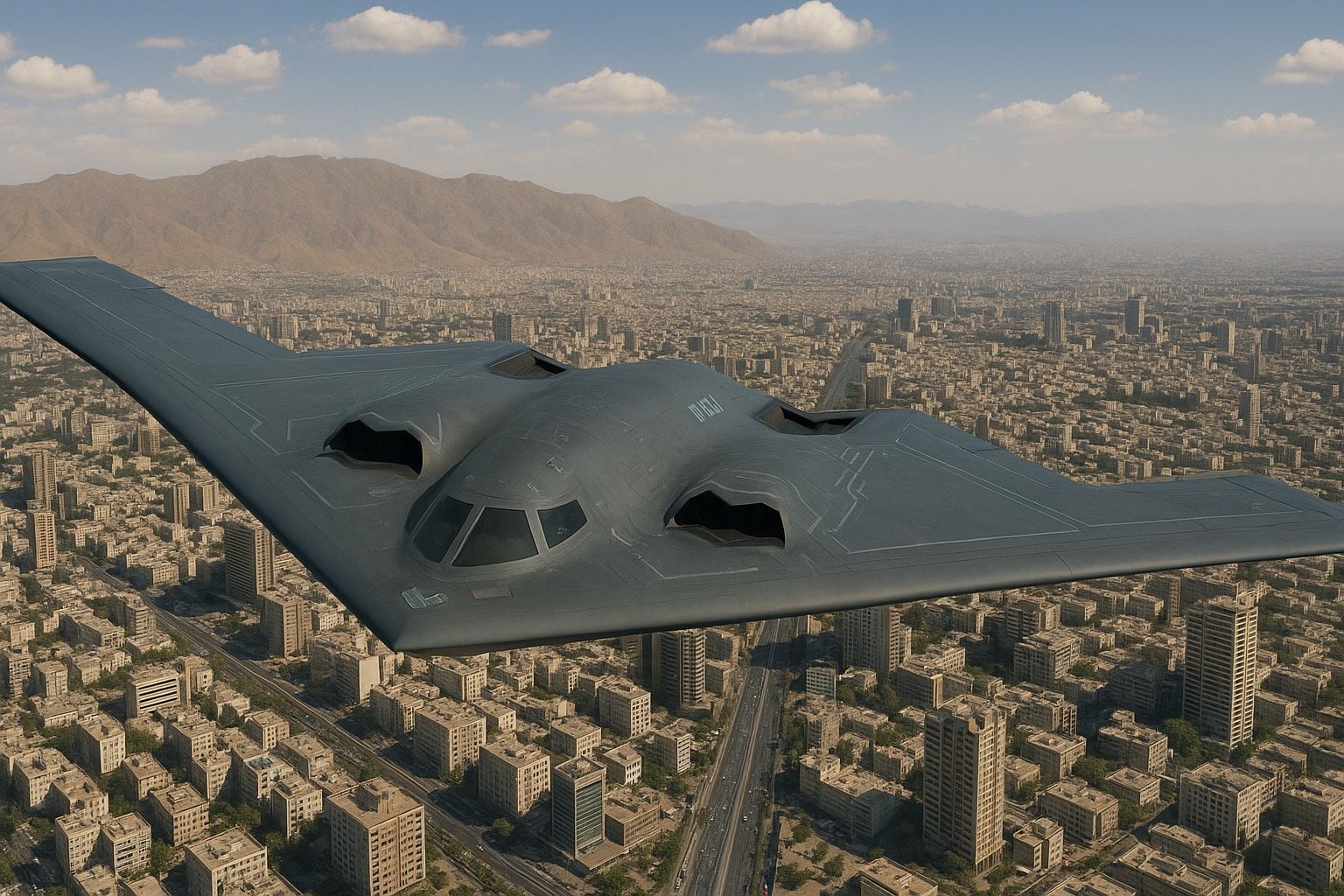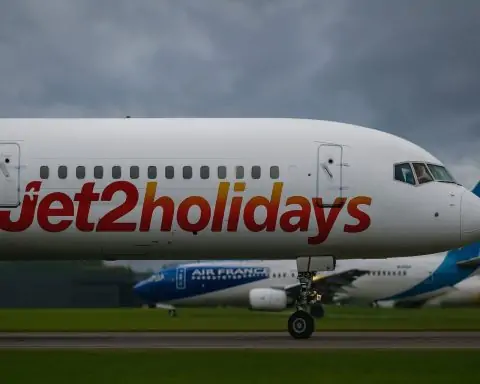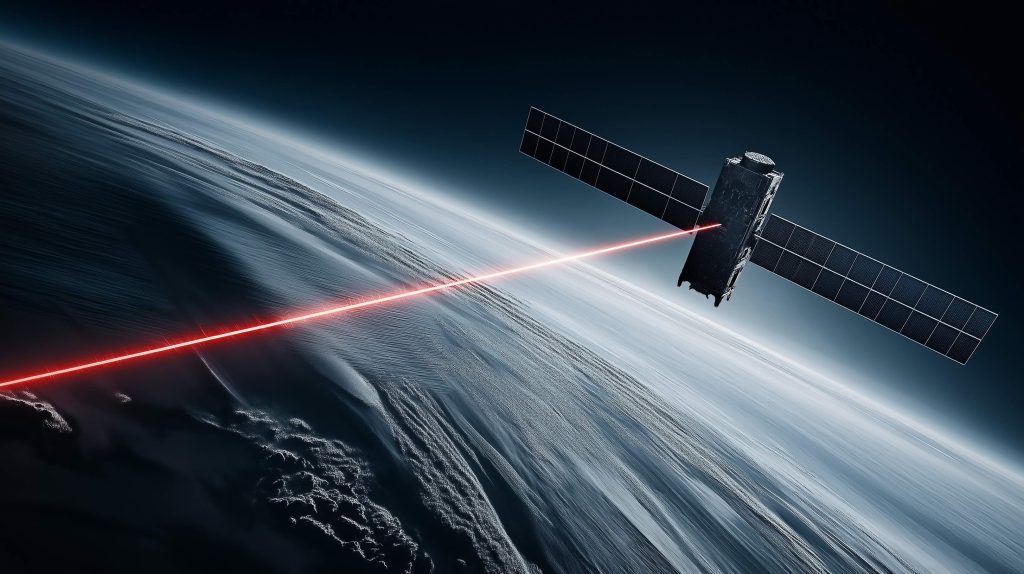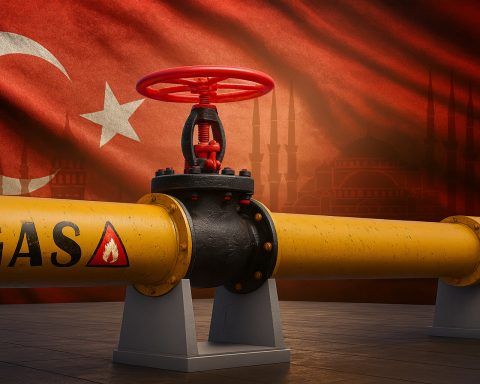- Operation Midnight Hammer, conducted June 21–22, 2025, targeted Iran’s Fordow, Natanz, and Isfahan nuclear sites.
- Seven B-2 Spirit bombers from the 509th Bomb Wing at Whiteman Air Force Base flew an 18-hour mission to Iran, delivering 14 GBU-57A/B Massive Ordnance Pens, marking the first-ever operational use of the MOP.
- To maximize surprise, at least six B-2s were observed flying west toward the Pacific as a decoy while seven B-2s proceeded east to strike.
- More than two dozen Tomahawk land-attack missiles were launched from an Ohio-class guided-missile submarine stationed in the Middle East to strike Isfahan around 2:15–2:35 AM local time.
- Fourteen MOPs struck Fordow and Natanz, collapsing underground halls and effectively taking Fordow off the table.
- The escort package included F-22 Raptors from the 1st Fighter Wing and F-35s, with F-16CJ Wild Weasel fighters and EA-18G Growlers providing SEAD and electronic attack.
- HARMs (AGM-88E AARGM) and electronic warfare assets, including EA-18G Growlers and EC-130H Compass Call, suppressed Iran’s radars and communications.
- A U.S. Navy Ohio-class SSGN submarine fired the Isfahan Tomahawk salvo, while the USS Nimitz (CVN-68) carrier strike group provided defense and support with Arleigh Burke destroyers and Ticonderoga cruisers.
- Whiteman AFB in Missouri served as the launch point, with KC-135 and KC-46 tankers refueling en route and staging at RAF Mildenhall, Al Udeid, Al Dhafra, and Diego Garcia.
- All three targets were struck within 6:40 PM and 7:05 PM Eastern Time, satellite imagery confirmed Fordow damage, President Trump praised the mission, and the Strait of Hormuz remained open despite Iran’s threats of retaliation.
June 21–22, 2025 – In a massive overnight strike, the United States unleashed a coordinated assault on Iran’s most fortified nuclear facilities – Fordow, Natanz, and Isfahan – under the code name Operation Midnight Hammer. This unprecedented attack, conducted in the early hours of June 22 local time, brought together America’s most advanced stealth bombers, fighter escorts, naval firepower, and specialized munitions in a highly choreographed operation [1] [2]. U.S. officials confirmed that the strikes “obliterated” Iran’s nuclear ambitions [3] by devastating critical enrichment sites buried deep underground. President Donald Trump announced that “a full payload of bombs was dropped on the primary site, Fordow,” and declared “all planes are safely on their way home”, lauding that “there is not another military in the world that could have done this” [4]. This report examines every platform and unit involved – from B-2 Spirit stealth bombers and F-22/F-35 fighters to Tomahawk cruise missiles and cyber units – and how they combined to deliver a historic blow to Iran’s nuclear program.
Stealth Bombers: B-2 Spirits Deliver Massive Bunker Busters
The spearhead of the strike was a formation of seven B-2 Spirit stealth bombers from the 509th Bomb Wing, Whiteman Air Force Base. These flying-wing stealth bombers penetrated Iranian airspace undetected, leveraging their low radar signature to avoid early warning [5]. Each B-2 was loaded with a pair of the Air Force’s heaviest conventional bombs – the GBU-57A/B Massive Ordnance Penetrator (MOP) – marking the first-ever operational use of this weapon [6]. The MOP is a 20.5-foot long, 30,000 lb bunker-busting bomb built to tunnel through 100+ feet of reinforced concrete before detonating [7]. B-2s can carry only two such gigantic bombs, which is why at least seven B-2s were needed to deliver the total of 14 MOPs used in the attack [8]. Flying in from Missouri, the stealth bombers executed an 18-hour inbound flight to the targets with minimal radio communications, maintaining strict secrecy [9]. In an impressive feat of global reach, they did not require any forward base (such as Diego Garcia) for this mission – instead refueling multiple times in mid-air from tanker aircraft along the way [10]. This marathon strike was in fact the largest B-2 combat operation in U.S. history and the second-longest B-2 mission ever flown [11] [12], exceeded only by post-9/11 deployments. As they neared Iran, the B-2s split to hit two hardened sites: the Fordow uranium enrichment bunker (buried under a mountain) and the Natanz nuclear facility. At approximately 2:10 AM local time in Iran, the lead B-2 dropped the first MOPs onto Fordow, followed within minutes by the other bombers striking their aimpoints [13] [14]. In total, 14 Massive Ordnance Penetrators pummeled the Fordow and Natanz sites, causing massive underground destruction and sealing off caverns [15] [16].
To maximize surprise and overcome Iran’s extensive air defenses, the B-2 strike incorporated clever deception tactics. Shortly before the attack, at least six B-2s were observed flying westward toward the Pacific – a decoy deployment that fooled observers into thinking the bombers were headed to Guam for a routine mission [17]. This ruse (planned by only a handful of insiders in Washington and at CENTCOM in Tampa) successfully diverted attention [18] [19], while the real strike package of seven B-2s flew east across the Atlantic and Mediterranean, staying under the radar – literally and figuratively. As a result of stealth and surprise, Iranian radar coverage was effectively nullified; not a single radar detected the incoming bombers, no fighters scrambled, and no shots were fired at U.S. aircraft during the attack [20] [21]. “America’s B-2 bombers struck deep inside Iran undetected. Not a single radar ping, no fighter response, no shots fired,” noted one U.S. official, emphasizing that no other nation could have pulled off such an operation [22].
Fighter Escorts and SEAD: F-22s, F-35s, and F-16s Suppress the Threat
Protecting the B-2s on their ingress and egress was a “package of fourth- and fifth-generation fighters” that linked up with the bombers as they approached Iran [23]. This escort force included the USAF’s premier stealth fighters – the F-22 Raptor – as well as F-35 Lightning II multirole fighters and other tactical jets. Multiple F-22s from the 1st Fighter Wing (Langley-Eustis, VA) had quietly deployed to Europe (RAF Lakenheath in the UK) on June 18 [24], a typical stopover en route to the Middle East. The F-22, America’s top air superiority platform, was poised to sweep the skies of any Iranian aircraft. In this operation, Raptors likely established combat air patrols and provided forward air dominance, though Iran’s air force never managed to respond in time [25].
Accompanying the F-22s were F-35 fighters, which brought stealth and advanced sensors to the fight. These fifth-generation jets acted as “eyes and ears” in the battlespace, detecting threats and jamming enemy sensors. As the strike package entered Iranian airspace, the escort fighters surged ahead at high altitude and high speed – effectively “sweeping in front of the package for enemy fighters and surface-to-air missile threats,” according to Gen. Dan Caine, Chairman of the Joint Chiefs [26] [27]. In addition, U.S. Central Command had pre-positioned certain specialized aircraft for Wild Weasel and electronic attack roles. Among them were likely F-16CJ Vipers equipped for SEAD (Suppression of Enemy Air Defenses) and U.S. Navy EA-18G Growlers for electronic jamming [28] [29]. Although officials did not publicly confirm each platform, a defense source noted the U.S. has “Air Force F-16 Wild Weasel fighters and Navy EA-18 electronic attack planes in the region” for this purpose [30].
As the B-2s neared their targets, this “protection package” unleashed high-speed anti-radiation missiles (HARMs) to take down or blind Iran’s remaining radar systems [31] [32]. “The U.S. protection package employed high-speed suppression weapons to ensure safe passage of the strike package, with fighter assets employing preemptive suppressing fires against any potential Iranian surface-to-air threats,” Gen. Caine explained [33]. This likely involved AGM-88E AARGM missiles homing in on Iranian SAM radars. In fact, reports emerged of “some of the most heavy wide-spectrum jamming of the war” blanketing Iranian communications and radar frequencies during the strike [34] [35] – a strong indication that U.S. electronic warfare units (possibly including EA-18G Growlers or specialized EC-130H Compass Call aircraft) were actively degrading Iran’s sensors and command networks. Thanks to these measures, Iran’s integrated air-defense system – already “heavily degraded by ongoing Israeli strikes” in the preceding week [36] [37] – never managed to engage the incoming U.S. jets. The fighters escorting the bombers reported no interference from Iranian interceptors or missiles [38]. In Caine’s words, the strike unfolded “flawlessly” with total surprise achieved: Iran’s fighters “did not fly, and it appears that Iran’s surface-to-air missile systems did not see us” at all [39].
Precision Ordnance: Bunker Busters, Cruise Missiles and Smart Bombs
The U.S. strike force employed a suite of specialized weapon systems to wipe out the three targeted nuclear sites. In total, about 75 precision-guided munitions were used against the Iranian facilities [40] [41]. At the tip of the spear were the GBU-57 MOP bunker-busting bombs delivered by the B-2s, as described earlier. Fourteen of these massive penetrators pulverized critical underground halls at Fordow and Natanz, collapsing tunnel networks and centrifuge chambers under tons of rubble [42] [43]. U.S. officials assessed that Fordow – Iran’s most deeply buried enrichment site – was effectively “taken off the table” by multiple direct hits [44] [45].
Meanwhile, the third target – the Isfahan uranium conversion facility – was attacked with a different approach. At roughly 5:00 PM Eastern Time (just minutes before the B-2s struck the other sites), the U.S. launched “more than two dozen” Tomahawk land-attack cruise missiles into the Isfahan complex [46]. These Tomahawk missiles, each a GPS-guided subsonic cruise missile with a 1,000+ mile range, were fired from a U.S. Navy submarine stationed in the Middle East. Officials did not name the vessel, but only the Navy’s four Ohio-class guided-missile submarines (SSGNs) carry the capacity for such a large salvo (up to 154 Tomahawks on board) [47] [48]. The submarine launch ensured the strike on Isfahan was near-simultaneous with the aerial hits on Fordow and Natanz – a coordinated timing to maximize shock and confusion. In fact, the Tomahawks were programmed to be “the last to strike at Isfahan to ensure we retain the element of surprise throughout the operation,” Gen. Caine noted [49]. Around 2:15–2:35 AM local time, as MOP bombs blasted the first two sites, over two dozen Tomahawks rained down on Isfahan, obliterating its above-ground infrastructure and any shallow underground facilities [50] [51].
Other precision weapons were also likely employed by U.S. fighters in supporting roles. For example, F-16CJ Vipers and F/A-18 Growlers firing the AGM-88 HARM/AARGM accounted for several of the “75 PGMs” tally, targeting Iranian air-defense radars just before and during the strike [52]. The escorting fighters may also have carried smaller JDAM precision bombs or SDB (Small Diameter Bomb) glide weapons to quickly destroy any mobile missile launchers or air defense batteries if they attempted to engage. However, because Iran’s defenses were caught off-guard and effectively blinded, the brunt of the destruction was delivered by the pre-planned ordnance: the bunker-busters from the air and the cruise missiles from the sea.
It’s worth noting the extraordinary coordination required to synchronize different munitions. The B-2 bomb drops and Tomahawk impacts had to be timed within a narrow window so that Iran’s leadership would have no warning or chance to hide critical assets. “All three Iranian nuclear infrastructure targets were struck between 6:40 PM and 7:05 PM Eastern time – about 2:10 to 2:35 AM in Iran,” the Joint Chiefs Chairman confirmed [53] [54]. By delivering a simultaneous knockout punch, the U.S. ensured maximum damage to Iran’s nuclear program in one fell swoop.
U.S. Navy’s Role: Carriers, Submarines, and Destroyers on Station
The United States Navy was deeply involved in supporting and executing the Iran strikes, providing both the launch platform for cruise missiles and a defensive umbrella in the region. The most direct Navy contribution was from a guided-missile submarine (likely an Ohio-class SSGN) that launched the salvo of Tomahawk cruise missiles at the Isfahan site [55] [56]. These Ohio-class SSGNs – converted Ohio-class nuclear submarines – are armed with up to 154 Tomahawks each and can unleash massive firepower from hidden positions underwater. Firing from somewhere in the Arabian Sea or Gulf of Oman, the U.S. submarine’s strike was coordinated to hit Isfahan moments after the B-2s struck Fordow and Natanz, as discussed above. By using a stealthy submersible platform, the Navy ensured surprise and reduced the risk that Iranian forces would detect or preempt the missile launch. Pentagon briefers noted that no other naval asset could have delivered “more than two dozen” land-attack missiles so rapidly, implying the use of an Ohio SSGN was essential [57].
In addition to the submarine, a carrier strike group had moved into position to backstop the operation. The USS Nimitz (CVN-68) and her accompanying warships were hastened to the U.S. Central Command area of responsibility in the days leading up to the strike [58]. While carrier aircraft did not need to carry out bombing runs on the nuclear sites (thanks to the B-2s and submarine taking charge of the strikes), the carrier’s air wing was likely on high alert. The Nimitz’s F/A-18E/F Super Hornet fighters and EA-18G Growlers provided a regional rapid response capability – for example, to fly combat air patrols or electronic jamming sorties if Iranian aircraft or missiles threatened U.S. assets. Indeed, the Navy’s electronic attack specialists from VAQ squadrons (operating Growlers) were almost certainly part of the operation’s support package, using powerful ALQ-99 jamming pods to disrupt Iranian radar and communications during the crucial minutes of the attack [59]. Navy surface combatants in the area, such as Arleigh Burke-class destroyers and Ticonderoga-class cruisers, also played a vital supporting role. These Aegis-equipped ships were on station in and around the Persian Gulf to provide air and missile defense for U.S. bases and allies – a necessary precaution given that Iran, or its proxies, might retaliate with ballistic missiles or drones. Earlier in the conflict, U.S. Navy destroyers had already helped intercept Iranian missiles aimed at Israel [60] [61]. Now, in the immediate aftermath of the strikes, those warships were prepared to shoot down any Iranian projectiles launched in anger toward U.S. forces.
While not explicitly used to fire Tomahawks in this strike, the Navy’s cruisers and destroyers were likely armed and ready for follow-on tasks. They could launch additional Tomahawk strikes if new targets emerged or if Iranian facilities needed a second wave. The presence of multiple U.S. Navy platforms – from carriers and guided-missile destroyers on the surface to the SSGN lurking below the waves – ensured robust maritime power projection and force protection throughout Operation Midnight Hammer. In summary, the Navy not only delivered a key portion of the ordnance (via its submarine-launched missiles), but also provided the command and control hub at sea, early warning via shipboard radars, and a deterrent to Iranian naval or missile counterattacks. As a result, all U.S. ships in the region remained safe and the Strait of Hormuz stayed open to shipping after the strike, despite Tehran’s threats [62] [63].
Overseas Bases and Staging: Whiteman to Al Udeid – Global Reach
Executing a strike of this magnitude required a network of air bases and staging locations spanning three continents. The mission’s starting point was Whiteman Air Force Base in Missouri, home of the B-2 Spirit fleet. All participating B-2 bombers launched from Whiteman just after midnight (EDT) on June 21 [64], beginning their long transatlantic journey. For mid-air refueling, the U.S. pre-positioned tanker aircraft along the route at various waypoints. Dozens of aerial tankers (KC-135 Stratotankers and KC-46 Pegasus) deployed from the U.S. and Europe to support the bombers [65] [66]. Notably, on June 18 the Air Force had sent over two dozen tankers to Europe as part of the buildup, staging many at RAF Mildenhall in the UK and other NATO airfields [67] [68]. This allowed the B-2s to refuel over the North Atlantic and again over the Mediterranean en route to the Middle East.
Enabling the fighter escort was a series of forward deployments. As mentioned, RAF Lakenheath in England received a contingent of F-22 Raptors from Langley AFB on June 18 [69], which likely then continued on to the CENTCOM region (either directly or via bases in the Middle East). In theater, Al Dhafra Air Base in the UAE and Al Udeid Air Base in Qatar served as key hubs. Al Dhafra has long hosted U.S. fighter squadrons and was a logical launch point for F-35s or F-16s that joined the strike package. Al Udeid, home of the U.S. Combined Air Operations Center, was the coordination nerve center for all air missions in the region. However, anticipating potential Iranian missile retaliation, the U.S. moved non-essential and large aircraft out of Al Udeid before the strike – for example, repositioning high-value surveillance and refueling planes to more distant locations [70]. Many support aircraft likely shifted to Ali Al Salem air base in Kuwait or Prince Sultan Air Base in Saudi Arabia (which U.S. forces have used in recent years), putting them farther from Iran’s immediate reach [71] [72]. Indeed, in the hours after the attack, U.S. military officials disclosed they had “moved larger planes away from Al Udeid Air Base, Qatar” as a precaution [73].
To cover contingencies, other bases were on standby as well. Diego Garcia, the remote Indian Ocean airfield, has historically been a bomber staging point; it likely was prepared as a divert or recovery site if any B-2 experienced an in-flight issue or required an alternate landing. (In the end, no such diversion was needed – all B-2s flew back to Missouri safely.) Incirlik Air Base in Turkey, while not openly involved, could have been used for emergency landing or search-and-rescue operations if a crew had to abort over the region. Additionally, U.S. and allied installations like NSA Souda Bay in Crete and Naval Support Activity Bahrain provided logistical backup and naval coordination for the operation. By leveraging this global network of bases – from the U.S. heartland to Europe and the Persian Gulf – the Pentagon demonstrated that it could project power globally with speed and precision at a time and place of its choosing [74] [75].
Support Units: Aerial Refueling, ISR, Cyber and Logistics Backbone
Executing Operation Midnight Hammer required an extensive supporting cast of units and capabilities working behind the scenes to enable the strike. Foremost among them was the fleet of aerial refueling tankers. The Air Force mobilized an armada of tanker aircraft to sustain the long-range bombers and fighter escorts. KC-135 Stratotankers and KC-46A Pegasus tankers converged from multiple air wings to refuel the B-2s as well as fighters like the F-22 and F-35 en route [76] [77]. General Caine highlighted that “dozens and dozens of air refueling tankers” (in multiple waves) were involved [78]. These tankers met the strike packages at pre-planned aerial refuel points over the Atlantic, the Med, and the Gulf, offloading thousands of pounds of fuel to keep the jets airborne over the 30-hour mission. Without this tanker bridge, the B-2s could not have reached Iran from Missouri without stopping. Thus, the unsung heroes in the sky were crews of units like the 100th Air Refueling Wing (at RAF Mildenhall) and other Air National Guard tanker squadrons, who executed critical mid-air top-offs on time.
Another indispensable element was ISR – Intelligence, Surveillance, and Reconnaissance. A “full array of intelligence, surveillance and reconnaissance aircraft” was deployed [79]. This likely included E-3 Sentry AWACS planes to monitor the air picture and manage the complex choreography of 125 aircraft in the theater. AWACS would detect any Iranian aircraft activity and coordinate friendly fighter patrols. RC-135 Rivet Joint signals intelligence jets were probably listening for Iranian military communications and radar emissions, feeding real-time intel to commanders. High-flying RQ-4 Global Hawk drones or U-2 spy planes could have been orbiting to provide photographic evidence of strike results within minutes of impact. Indeed, within hours, satellite imagery from commercial providers showed massive damage at Fordow [80], confirming the success. Meanwhile, MQ-9 Reaper drones and other UAVs were on station for persistent surveillance, ready to track any Iranian troop movements or hunt for mobile missile launchers if Iran retaliated. The operation was also supported by space-based assets – U.S. surveillance satellites likely watched Iran’s airfields and airspace in real time, and provided secure communications links for the strike force. In sum, a comprehensive ISR umbrella “from above the clouds to beyond the atmosphere” ensured U.S. commanders had excellent situational awareness throughout the mission [81] [82].
Crucially, cyber warfare units and electronic warfare teams played a major role in crippling Iran’s ability to respond. Reports indicate that as the strike began, Iran was hit with “massive attacks across the electronic spectrum”, causing heavy jamming of radios, GPS, and cellular networks [83] [84]. This suggests that U.S. Cyber Command and NSA cyber operators executed offensive operations to disrupt Iranian communications and command-and-control systems at the moment of impact. By injecting malware or launching cyber attacks on Iranian air defense networks and early-warning systems, the U.S. likely blinded Iran’s decision-makers (“breaking their decision cycle”) during the critical window of the strike [85] [86]. Simultaneously, U.S. Navy EA-18G Growlers and possibly Air Force EC-130H electronic attack planes provided on-the-spot jamming of Iranian radar frequencies and communications, as mentioned earlier. This one-two punch of cyber and electronic warfare ensured that Iranian commanders were deaf, dumb, and blind in the critical minutes – unable to coordinate any coherent response while their nuclear sites were under attack.
Behind all these operations was an enormous logistics and maintenance effort. The Pentagon revealed that “hundreds of maintenance and operational professionals” were involved in making this mission possible [87]. In Missouri, ground crews at Whiteman AFB worked around the clock to prepare the B-2 fleet – a process likely involving transporting and loading the 30,000-lb MOP bombs into the bombers’ bays, a delicate task done for the first time in a combat scenario. Munitions specialists, avionics technicians, and stealth coating maintainers ensured each B-2 was mission-capable. At tanker bases from the U.S. to Europe, logistics airmen coordinated fuel loads, while at forward bases in CENTCOM, personnel readied fighters and support jets for immediate launch. Airlift command also played a part: C-17 Globemaster III transport planes had ferried personnel, weapons, and supplies into position in the days beforehand to support U.S. deployments (for example, airlifting spare parts and support teams to Lakenheath for the incoming F-22s). Medical evacuation teams and search-and-rescue helicopters were surely on alert as well (though thankfully unneeded). The entire operation was a showcase of U.S. joint-force integration, relying on tight synchronization among Air Force, Navy, Marine Corps, Space Force, and cyber units. As Gen. Caine put it, “this mission was planned and executed across multiple domains and theaters with coordination that reflects our ability to project power globally” at will [88] [89].
Command and Control: From the White House to CENTCOM
The strike on Iran’s nuclear sites was directed at the highest levels of the U.S. government, with a clear chain of command ensuring both secrecy and effectiveness. President Donald Trump, as Commander-in-Chief, made the fateful decision to launch the attack – the first U.S. direct military strike on Iranian soil since 1979 [90]. In the days prior, Trump had given Iran a last warning ultimatum to cease nuclear activities, and when that failed, he authorized Operation Midnight Hammer in consultation with his national security advisors [91] [92]. On the night of June 21, Trump and his top war council gathered in the White House Situation Room to monitor the operation. Photos later released show the President flanked by Vice President J.D. Vance, Secretary of State Marco Rubio, Defense Secretary Pete Hegseth, Chairman of the Joint Chiefs Gen. Dan “Razin” Caine, and White House Chief of Staff Susie Wiles as the strike was underway [93] [94]. This team received live updates from the Pentagon and CENTCOM as bombs fell on target. President Trump delivered a brief national address once the planes exited Iranian airspace, praising the U.S. military’s “precision, speed and skill” and warning Iran that any retaliation “will be met with force far greater than what was witnessed tonight” [95].
On the military side, operational control lay with U.S. Central Command (CENTCOM), headquartered in Tampa, Florida (MacDill AFB). Given the extraordinary sensitivity, planning was kept tightly compartmentalized among a small cell of planners at CENTCOM and the Joint Staff. Gen. Caine noted that “very few people in Washington and in Tampa” knew the timing or details of the plan [96] [97]. General Michael Kurilla (CENTCOM Commander) or his designated air component commanders would have overseen the execution once the go-order was given. The Combined Air Operations Center (CAOC) at Al Udeid Air Base functioned as the command-and-control hub, managing the complex air tasking order – from tankers to bombers to ISR assets – via secure data-links and satellite comms. In practice, an ad-hoc Joint Task Force may have been established to unify the strike effort, led by a senior Air Force officer for the air component and a Navy flag officer coordinating the naval cruise missile strike. The Chairman of the Joint Chiefs, Gen. Caine, stayed in constant communication with field commanders and the Secretary of Defense, ready to advise on any necessary adjustments or responses to contingencies [98] [99].
At the Pentagon, SecDef Pete Hegseth managed the inter-agency and international coordination. The U.S. had quietly informed a few key allies – notably Israel – just before the strike, to deconflict any air operations. (CNN reported that Israel’s government was notified that the U.S. strike was imminent, which “makes absolute sense as not doing that could lead to disaster,” given Israeli jets were also active over Iran [100].) In fact, this U.S. attack came on Day 9 of an ongoing Israel-Iran conflict, during which Israel’s military (Operation “Rising Lion”) had been heavily bombarding Iranian forces and nuclear sites but had not been able to permanently eliminate the deeply buried facilities [101] [102]. Israel’s defense establishment was aware that Fordow in particular was beyond their strike capacity – “the U.S. is the only country with the necessary bombers and munitions to destroy it,” as one analysis noted prior to the attack [103] [104]. Thus, the U.S. strike was closely coordinated with Israel’s campaign. Hegseth later remarked that “Israel had incredible military success… but as it pertains to this strike, this was U.S.-operated, U.S.-led” [105] [106]. Indeed, Israeli forces had severely degraded Iran’s air defenses in the week leading up to June 21, laying the groundwork for the B-2s to penetrate with ease [107]. “We took advantage of some of the preparatory work done over the past week and a half in terms of access and approach,” Gen. Caine acknowledged [108]. However, he was clear that “what was left was to do the work that only the U.S. Air Force could accomplish, with its unique combination of bombers, bombs, and support capabilities” [109].
Throughout the operation, command and control was maintained at multiple redundant layers. Secure satellite communications (SATCOM) linked the President and Pentagon to airborne command posts. An E-4B National Airborne Operations Center might have been airborne as a backup command node. Within theater, AWACS and JSTARS aircraft provided tactical C2 for the strike package. At sea, the USS Nimitz acted as a floating headquarters for naval and air defense coordination. In the cyber realm, U.S. Cyber Command’s operations center orchestrated the timing of cyber attacks to coincide with kinetic strikes. Such multi-domain integration required clear centralized authority and disciplined execution of pre-planned phases. As Gen. Caine described, it was a textbook example of joint, combined-arms warfare: “done with exact synchronization across multiple platforms in a narrow piece of airspace, all with minimal communications. This type of integration is exactly what our Joint Force does better than anyone else in the world” [110] [111].
Finally, once bombs hit their targets, the command focus shifted to assessment and containment. The Pentagon convened a morning briefing on June 22 where SecDef Hegseth and Gen. Caine provided initial battle damage assessments – reporting that all weapons hit their marks and all aircraft returned safely [112] [113]. President Trump, in his address, praised the military’s flawless execution and expressed hope that this decisive strike “serves the security interests of the entire free world” and might force Iran back to the negotiating table [114] [115]. At the same time, U.S. forces in the region were placed on high alert. Contingency plans were ready for Iranian reprisals: additional Patriot and THAAD air defense units were activated around U.S. bases, and as noted, non-essential personnel and aircraft were relocated to safer areas [116]. Diplomatic and informational efforts also kicked into gear – for instance, the U.S. Ambassador to the UN was directed to justify the strikes as a counter-proliferation measure, even as Iran’s government angrily denounced them as “outrageous and unlawful” and requested an emergency UN Security Council meeting [117] [118].
Conclusion: A Devastating Blow and Global Aftershocks
Operation Midnight Hammer demonstrated the pinnacle of American military prowess – a carefully calibrated strike that combined stealth technology, precision firepower, and vast logistical reach. In a single night, the United States set Iran’s nuclear program back by years, destroying heavily fortified sites that had long been deemed nearly impervious to attack. “Our initial assessment is that all of our precision munitions struck where we wanted and had the desired effect,” Secretary Hegseth affirmed, “especially in Fordow, which was the primary target” [119]. Independent satellite photos confirmed the crippling damage, with Fordow’s underground halls collapsed and vent shafts blown apart [120]. Iranian officials were defiant but shaken – Iran’s Atomic Energy Organization condemned the strike as “lawlessness…the rules of the jungle,” even as it vowed to continue Iran’s nuclear work in some form [121]. The strategic ramifications were immediate: Tehran’s ability to enrich weapons-grade uranium was dealt a severe blow, but the risk of broader war spiked overnight. The world braced for Iran’s response, which as of the next day included limited missile volleys toward Israel and vows of future revenge [122] [123].
For the U.S. and its allies, the operation was a dramatic assertion of resolve. American leaders from the President on down highlighted that this strike was aimed at “Iran’s nuclear program, not the Iranian people”, drawing a distinction that it was a non-nuclear preemptive strike to prevent a greater threat [124]. President Trump proclaimed, “now is the time for peace,” after congratulating the “great American warriors” who executed the mission [125]. U.S. commanders emphasized that the strike was a “one-time” action to neutralize a specific threat, not the start of a full-scale war [126]. Nonetheless, the Pentagon remained on high alert. Air defense and naval units stayed poised to counter any attempt by Iran to retaliate against U.S. forces in the Gulf. The Strait of Hormuz – vital to global oil shipping – became a focal point of tension, though U.S. Naval forces ensured it stayed open despite Iran’s rhetoric about closing it [127] [128].
In Congress and abroad, reactions were deeply split. American allies like Israel hailed the operation – Israeli Prime Minister Netanyahu said the U.S. “acted with a lot of strength” and that the strikes “will change history” in preventing an Iranian bomb [129]. Gulf Arab partners quietly approved of the blow to Iran’s ambitions, even as they prepared for potential fallout in the region. Within the U.S., supporters lauded the decisive action (“The President made the correct decision…Iran would only be stopped by force,” said one Senate Armed Services Committee leader [130]), while critics in Congress warned of the risk of escalation and the lack of explicit authorization for a new conflict [131] [132]. The Pentagon’s briefers, for their part, took a victory lap in describing the operation’s flawless execution, but also struck a cautious tone that this was “far too early to call mission accomplished” [133]. Iran’s capability to retaliate via proxies or missiles remained a serious concern, and U.S. forces would remain heavily engaged in missile defense and regional security in the days to come [134].
Operation Midnight Hammer will likely be studied for years as a prime example of modern American military integration – showcasing how stealth assets, cyber/electronic warfare, precision weaponry, and joint planning can combine to take out even the most hardened of targets. It underscored the unique capabilities the U.S. military possesses. As one observer noted, the mission that unfolded “included assets from below the waves to space” [135] [136] – in other words, every domain of warfare was brought to bear. “No other military in the world could have done this,” President Trump asserted in the strike’s aftermath [137], a statement even some critics might find hard to dispute. Whether this bold action ultimately deters Iran’s nuclear ambitions or propels a new chapter of conflict is a question only time will answer. But for now, the world has witnessed the extraordinary reach and precision of U.S. power when marshaled against a critical threat.
Sources: The details in this report are drawn from official Pentagon briefings, on-scene reporting, and defense analysis of the Iran strikes, including Air & Space Forces Magazine [138] [139], The War Zone (Tyler Rogoway, Howard Altman et al.) [140] [141], U.S. Naval Institute News, and Washington Post live updates [142] [143], among other cited sources. These provide a comprehensive, factual account of the units and capabilities involved in the June 21–22, 2025 operation.
References
1. www.airandspaceforces.com, 2. www.twz.com, 3. www.twz.com, 4. en.wikipedia.org, 5. www.twz.com, 6. www.twz.com, 7. www.reddit.com, 8. www.airandspaceforces.com, 9. www.twz.com, 10. www.airandspaceforces.com, 11. www.twz.com, 12. www.twz.com, 13. www.twz.com, 14. www.twz.com, 15. www.twz.com, 16. www.twz.com, 17. www.airandspaceforces.com, 18. www.twz.com, 19. www.twz.com, 20. www.twz.com, 21. www.twz.com, 22. www.twz.com, 23. www.twz.com, 24. www.airandspaceforces.com, 25. www.twz.com, 26. www.airandspaceforces.com, 27. www.twz.com, 28. www.airandspaceforces.com, 29. www.twz.com, 30. www.airandspaceforces.com, 31. www.airandspaceforces.com, 32. www.airandspaceforces.com, 33. www.airandspaceforces.com, 34. www.twz.com, 35. www.twz.com, 36. www.reddit.com, 37. www.airandspaceforces.com, 38. www.twz.com, 39. www.twz.com, 40. www.twz.com, 41. www.twz.com, 42. www.twz.com, 43. www.twz.com, 44. www.twz.com, 45. www.twz.com, 46. www.twz.com, 47. www.twz.com, 48. www.twz.com, 49. www.twz.com, 50. www.twz.com, 51. www.twz.com, 52. www.twz.com, 53. www.twz.com, 54. www.twz.com, 55. www.twz.com, 56. www.twz.com, 57. www.twz.com, 58. www.airandspaceforces.com, 59. www.twz.com, 60. www.airandspaceforces.com, 61. www.airandspaceforces.com, 62. www.twz.com, 63. www.twz.com, 64. www.airandspaceforces.com, 65. www.airandspaceforces.com, 66. www.airandspaceforces.com, 67. www.airandspaceforces.com, 68. www.airandspaceforces.com, 69. www.airandspaceforces.com, 70. www.airandspaceforces.com, 71. www.airandspaceforces.com, 72. www.airandspaceforces.com, 73. www.airandspaceforces.com, 74. www.twz.com, 75. www.twz.com, 76. www.airandspaceforces.com, 77. www.airandspaceforces.com, 78. www.twz.com, 79. www.twz.com, 80. www.twz.com, 81. www.twz.com, 82. www.twz.com, 83. www.twz.com, 84. www.twz.com, 85. www.twz.com, 86. www.twz.com, 87. www.twz.com, 88. www.twz.com, 89. www.twz.com, 90. www.washingtonpost.com, 91. en.wikipedia.org, 92. www.twz.com, 93. www.airandspaceforces.com, 94. www.washingtonpost.com, 95. www.washingtonpost.com, 96. www.twz.com, 97. www.twz.com, 98. www.twz.com, 99. www.twz.com, 100. www.twz.com, 101. www.airandspaceforces.com, 102. www.airandspaceforces.com, 103. www.airandspaceforces.com, 104. www.airandspaceforces.com, 105. www.airandspaceforces.com, 106. www.airandspaceforces.com, 107. www.airandspaceforces.com, 108. www.airandspaceforces.com, 109. www.airandspaceforces.com, 110. www.twz.com, 111. www.twz.com, 112. www.twz.com, 113. www.twz.com, 114. www.washingtonpost.com, 115. www.washingtonpost.com, 116. www.airandspaceforces.com, 117. www.washingtonpost.com, 118. www.washingtonpost.com, 119. www.twz.com, 120. www.twz.com, 121. www.washingtonpost.com, 122. www.washingtonpost.com, 123. www.washingtonpost.com, 124. www.reddit.com, 125. www.twz.com, 126. www.twz.com, 127. www.twz.com, 128. www.twz.com, 129. www.washingtonpost.com, 130. www.airandspaceforces.com, 131. www.airandspaceforces.com, 132. www.airandspaceforces.com, 133. www.twz.com, 134. www.twz.com, 135. www.twz.com, 136. www.twz.com, 137. en.wikipedia.org, 138. www.airandspaceforces.com, 139. www.airandspaceforces.com, 140. www.twz.com, 141. www.twz.com, 142. www.washingtonpost.com, 143. www.washingtonpost.com









